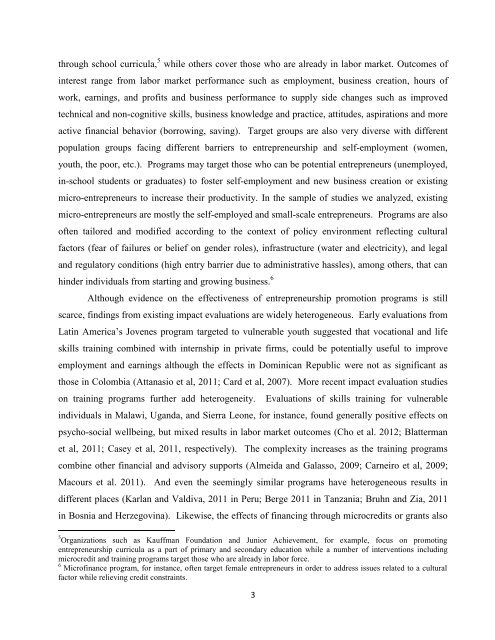Entrepreneurship Programs in Developing Countries: A ... - IYFLive.net
Entrepreneurship Programs in Developing Countries: A ... - IYFLive.net
Entrepreneurship Programs in Developing Countries: A ... - IYFLive.net
Create successful ePaper yourself
Turn your PDF publications into a flip-book with our unique Google optimized e-Paper software.
through school curricula, 5 while others cover those who are already <strong>in</strong> labor market. Outcomes of<strong>in</strong>terest range from labor market performance such as employment, bus<strong>in</strong>ess creation, hours ofwork, earn<strong>in</strong>gs, and profits and bus<strong>in</strong>ess performance to supply side changes such as improvedtechnical and non-cognitive skills, bus<strong>in</strong>ess knowledge and practice, attitudes, aspirations and moreactive f<strong>in</strong>ancial behavior (borrow<strong>in</strong>g, sav<strong>in</strong>g). Target groups are also very diverse with differentpopulation groups fac<strong>in</strong>g different barriers to entrepreneurship and self-employment (women,youth, the poor, etc.). <strong>Programs</strong> may target those who can be potential entrepreneurs (unemployed,<strong>in</strong>-school students or graduates) to foster self-employment and new bus<strong>in</strong>ess creation or exist<strong>in</strong>gmicro-entrepreneurs to <strong>in</strong>crease their productivity. In the sample of studies we analyzed, exist<strong>in</strong>gmicro-entrepreneurs are mostly the self-employed and small-scale entrepreneurs. <strong>Programs</strong> are alsooften tailored and modified accord<strong>in</strong>g to the context of policy environment reflect<strong>in</strong>g culturalfactors (fear of failures or belief on gender roles), <strong>in</strong>frastructure (water and electricity), and legaland regulatory conditions (high entry barrier due to adm<strong>in</strong>istrative hassles), among others, that canh<strong>in</strong>der <strong>in</strong>dividuals from start<strong>in</strong>g and grow<strong>in</strong>g bus<strong>in</strong>ess. 6Although evidence on the effectiveness of entrepreneurship promotion programs is stillscarce, f<strong>in</strong>d<strong>in</strong>gs from exist<strong>in</strong>g impact evaluations are widely heterogeneous. Early evaluations fromLat<strong>in</strong> America’s Jovenes program targeted to vulnerable youth suggested that vocational and lifeskills tra<strong>in</strong><strong>in</strong>g comb<strong>in</strong>ed with <strong>in</strong>ternship <strong>in</strong> private firms, could be potentially useful to improveemployment and earn<strong>in</strong>gs although the effects <strong>in</strong> Dom<strong>in</strong>ican Republic were not as significant asthose <strong>in</strong> Colombia (Attanasio et al, 2011; Card et al, 2007). More recent impact evaluation studieson tra<strong>in</strong><strong>in</strong>g programs further add heterogeneity. Evaluations of skills tra<strong>in</strong><strong>in</strong>g for vulnerable<strong>in</strong>dividuals <strong>in</strong> Malawi, Uganda, and Sierra Leone, for <strong>in</strong>stance, found generally positive effects onpsycho-social wellbe<strong>in</strong>g, but mixed results <strong>in</strong> labor market outcomes (Cho et al. 2012; Blatterma<strong>net</strong> al, 2011; Casey et al, 2011, respectively). The complexity <strong>in</strong>creases as the tra<strong>in</strong><strong>in</strong>g programscomb<strong>in</strong>e other f<strong>in</strong>ancial and advisory supports (Almeida and Galasso, 2009; Carneiro et al, 2009;Macours et al. 2011). And even the seem<strong>in</strong>gly similar programs have heterogeneous results <strong>in</strong>different places (Karlan and Valdiva, 2011 <strong>in</strong> Peru; Berge 2011 <strong>in</strong> Tanzania; Bruhn and Zia, 2011<strong>in</strong> Bosnia and Herzegov<strong>in</strong>a). Likewise, the effects of f<strong>in</strong>anc<strong>in</strong>g through microcredits or grants also5 Organizations such as Kauffman Foundation and Junior Achievement, for example, focus on promot<strong>in</strong>gentrepreneurship curricula as a part of primary and secondary education while a number of <strong>in</strong>terventions <strong>in</strong>clud<strong>in</strong>gmicrocredit and tra<strong>in</strong><strong>in</strong>g programs target those who are already <strong>in</strong> labor force.6 Microf<strong>in</strong>ance program, for <strong>in</strong>stance, often target female entrepreneurs <strong>in</strong> order to address issues related to a culturalfactor while reliev<strong>in</strong>g credit constra<strong>in</strong>ts.3
















